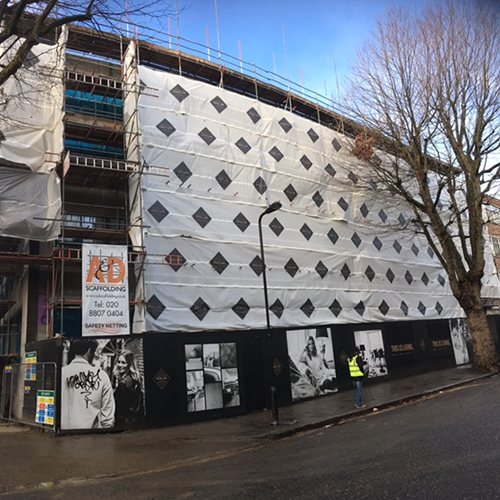ONE OF OUR LATEST PROJECTS IN

Location-zenith house Tottenham, London
Description- commercial property renovation to studio flats.
TOTTENHAM, LONDON
Tottenham was named after Tota, a farmer, whose hamlet was mentioned in the Domesday Book. The settlement was recorded in the Domesday Book as Toteham.
When the Domesday Book was compiled in 1086, about 70 families lived within the area of the manor. These were mostly labourers working for the Lord of the Manor. A humorous poem entitled the Tournament of Tottenham, written around 1400, describes a mock-battle between peasants vying for the reeve‘s daughter.
In 1894, Tottenham was made an urban district. On 27 September 1934 it became a municipal borough. As from 1 April 1965, the municipal borough formed part of the London Borough of Haringey together with Hornsey and Wood Green.
The River Lea (or Lee) was the eastern boundary between the Municipal Boroughs of Tottenham and Walthamstow. It is the ancient boundary between Middlesex and Essex and also formed the western boundary of the Viking controlled Danelaw. Today it is the boundary between the London Boroughs of Haringey and Waltham Forest. A major tributary of the Lea, the River Moselle, also crosses the borough from west to east. It also often caused serious flooding until it was mostly covered in the 19th century.
From the Tudor period onwards, Tottenham became a popular recreation and leisure destination for wealthy Londoners. Henry VIII is known to have visited Bruce Castle and also hunted in Tottenham Wood. The area became noted for its large Quaker population and its schools (including Rowland Hill‘s at Bruce Castle where it remained a semi-rural and upper middle class area until the 1870s.
Modern era
In late 1870, the Great Eastern Railway introduced special workman’s trains and fares on its newly opened Enfield and Walthamstow branch lines. Tottenham’s low-lying fields and market gardens were then rapidly transformed into cheap housing for the lower middle and working classes. They were able to commute cheaply to inner London. The workman’s fare policy stimulated the relatively early development of the area into a London suburb.
An incident occurred on 23 January 1909, which was at the time known as the Tottenham Outrage. Two armed robbers of Russian extraction held up the wages clerk of a rubber works in Chesnut Road. They made their getaway via Tottenham Marshes and fled across the Lea. On the opposite bank of the river they hijacked a Walthamstow Corporation tramcar, hotly pursued by the police on another tram. The hijacked tram was stopped but the robbers continued their flight on foot. After firing their weapons and killing two people, Ralph Joscelyne, aged 10, and PC William Tyler, they were eventually cornered by the police and shot themselves rather than be captured. Fourteen other people were wounded during the chase. The incident later became the subject of a silent film.
During the Second World War Tottenham was one of the many targets of the German air offensive against Britain. Bombs fell in the borough (Elmar Road) during the first air raid on London on 24 August 1940. The borough also received V-1 (four incidents) and V-2 hits, the last of which occurred on 15 March 1945. Wartime shortages led to the creation of Tottenham Pudding, a mixture of household waste food which was converted into feeding stuffs for pigs and poultry. The “pudding” was named by Queen Mary on a visit to Tottenham Refuse Works. Production continued into the post-war period, its demise coinciding with the merging of the borough into the new London Borough of Haringey.
Location : Aldwych, London
Description- access up and over to provide access to replace fire escape on rear elevation.
Hoist tower to front elevation.
ALDWYCH, LONDON
Aldwych is a one-way street and the name of the area immediately surrounding it in central London, England.
The area, unlike the adjoining Temple area, also participated in the county of Middlesex until 1965.
It also forms part of the A4 road from London to Avonmouth, Bristol.
The Aldwych area forms part of the Northbank business improvement district.
It is also known for hotels, restaurants, two theatres and also the High Commmissions of India and Australia.
Its associated Underground station on the related section of the Strand (the return of the crescent) poses as an active tube station in films and television shows. Whilst also marking the east end of the street and in the middle of the crescent return are Grade I architecturally listed churches designed by Wren and Gibbs.
Immediately north-east of St Clement Danes (St Clements) is the complex of courts which includes the Court of Appeal of England and Wales, the Royal Courts of Justice.
A & D Scaffolding Services Ltd
Unit 1b Towpath Road
Stonehill Business Park
Edmonton
London N18 3QX
Registered in England and Wales
Company Registration : 6647376
Vat Registration : 987757535
Monday - Friday : 9am to 5pm
Saturday : Appointment Only
Sunday : Closed All Day
Call 07960 911802
 Project – Aldwych | London28th August 2023 - 6:53 pm
Project – Aldwych | London28th August 2023 - 6:53 pm Project – Mayfair | London12th August 2023 - 8:34 am
Project – Mayfair | London12th August 2023 - 8:34 am Project – Tottenham | London4th September 2021 - 7:42 pm
Project – Tottenham | London4th September 2021 - 7:42 pm

